Source:- Google.com.pk
Fine Art Biography
Bing (Chinese: 徐冰 b. 1955) is a Chinese-born artist, resident in the United States since 1990. He currently resides in Beijing, where he serves as the vice-president of the Central Academy of Fine Arts. He is most known for his printmaking skills and installations pieces, as well as his creative artistic use of language, words, and text and how they have affected our understanding of the world.
Contents [hide]
1 Biography
2 Art
2.1 Early Works
2.2 Installation Pieces
2.2.1 A Book from the Sky
2.2.2 Ghosts Pounding the Wall
2.2.3 Background Story
2.3 Later Mediums
3 Influences and themes
4 Awards and honors
5 Partial list of works
6 References
7 External links
[edit]Biography
Born in Chongqing in 1955, Xu grew up in Beijing. In 1975, near the end of the Cultural Revolution, he was relocated to the countryside for two years. Returning to Beijing in 1977, he enrolled at the Central Academy of Fine Arts(CAFA) where he joined the printmaking department, receiving his Masters in Fine Art in 1987. After the Tiananmen Square Protests of 1989 his recent work came under scrutiny from the government and received harsh criticism for what was perceived as a critique of the Chinese government. Due to the political pressure and artistic restrictions of the post-Tiananmen period in China, Xu Bing, like many of his contemporaries, moved to the United States in 1990, where he resided until his appointment as vice-president of the Beijing CAFA in 2008.
In 1990-91, Xu had his first exhibition in the United States at the University of Wisconsin–Madison's Elvehjem Museum of Art (now Chazen Museum of Art) including his installations Book from the Sky and Ghosts Pounding the Wall. In Book from the Sky, the artist invented 4,000 characters and hand-carved them into wood blocks, then used them as movable type to print volumes and scrolls, which are displayed laid out on the floor and hung from the ceiling. The vast planes of text seem to convey ancient wisdom, but are in fact unintelligible. The Glassy Surface of a Lake, a site-specific installation for the Elvehjem, was on view in 2004-05. In this work, a net of cast aluminum letters forming a passage from Henry David Thoreau's Walden stretches across the museum's atrium and pours down into an illegible pile of letters on the floor below.
Xu Bing at the Asian Art Museum of San Francisco on January 28, 2011.
Working in a wide range of media, Xu creates installations that question the idea of communicating meaning through language, demonstrating how both meanings and written words can be easily manipulated. He received a MacArthur Foundation "genius" award in July 1999, presented to him for "originality, creativity, self-direction, and capacity to contribute importantly to society, particularly in printmaking and calligraphy."
In 2003 he exhibited at the then new Chinese Arts centre in Manchester, and in 2004 he won the inaugural "Artes Mundi" prize in Wales for Where does the dust collect itself?, an installation using dust he collected in New York on the day after the destruction of the World Trade Center.[1] He won also a half year of free work and study at the American Academy in Berlin 2004.[2]
Xu Bing was appointed the new vice president of the China Central Academy of Fine Arts in Beijing, March 2008.[3][4]
[edit]Art
[edit]Early Works
While at the Central Academy of Fine Arts Xu Bing mastered the Socialist Realism style of art so predominant during the Maoist era. After graduating with his degree in printmaking, the artist veered away and created simple but dramatic woodcuts, such as Shattered Jade (1977) and Bustling Village on the Water (1980-81, 繁忙的水乡).[5] In 1987, Xu Bing returned to his training in printmaking to create large and elaborate installation pieces like Book from the Sky (1987) and Ghosts Pounding the Wall (1990).
[edit]Installation Pieces
[edit]A Book from the Sky
Xu Bing’s Tianshu (“Book From the Sky”) is a large installation featuring precisely laid out rows of books and hanging scrolls with written “Chinese” texts. Even so, this work challenges our very approach to language because of the unique nature of the text written on the paper. First presented in Beijing in 1988, the learned élite felt slighted by the artists’ bold move to design and print over 4,000 characters that looked Chinese but were completely meaningless according to standard Mandarin.[6] Xu Bing infuses his work with meaning by stirring confusion and discomfort in his audience, mostly due to the fact that the Chinese characters used in these texts are not “real” characters.
This piece was well received in China until 1989, whereupon the social and political drama of the Tiananmen Square protests led the government to look askance at Xu Bing’s Tianshu.[7] Leaving China in 1991 for the political and artistic freedom of the United States, Xu Bing continued to explore and express his thoughts on deconstructing language to challenge our most “natural” cultural assumptions. His thought-provoking work enticed Western audiences, and he soon became one of the leading artists in the modern Chinese art scene.
[edit]Ghosts Pounding the Wall
Using his background in print-making, in May and June 1990 Xu Bing and a team of art students and help from local residents began a monumental project: creating a rubbing from a section of the Great Wall at Jinshanling. In order to create the rubbings, Xu Bing used entirely traditional Chinese methods and materials for stone rubbing, including rice paper and ink. Measuring 32m x 15m, the resulting installation piece consists of 29 rubbings of different sections of the Great Wall.
As is the case of many of his works, Xu Bing directly related his colossal piece "Ghosts Pounding the Wall" to the political situation in China. While surveying his work while installed at Elvehjem Museum of Art, Xu Bing said that his Great Wall represents "a kind of thinking that makes no sense and is very conservative, a really closed-in thinking that symbolizes the isolationism of Chinese politics."[8] The prints of the Great Wall rise up on either side of the exhibit, making the viewer seem small and insignificant in comparison to the massive, looming representations of solid stone walls.
[edit]Background Story
In his series Background Story[9], Xu Bing uses unusual materials in order to create a deceptively typical Chinese Scroll Painting. From the front, the piece very much resembles a traditional Shan Shui (Landscape) scroll painting, with images of mountains, trees, and rivers. However, when seen from behind, the viewer is surprised to find that the beautiful "painting" is in fact created by using the shapes and shadows of random natural plant debris. Once again, Xu Bing challenges his audience's basic assumptions and shows them that everything is not always as it first seems.
[edit]Later Mediums
Xu Bing’s art medium has clearly evolved over the years, morphing from one style to the next: print-making and wood-block carving, installation art, live installation art, metalwork and sculpture, landscaping, and even virtual and digital mediums.
Taking installation art a step further, Xu Bing focused on live installation art by using animals in his exhibits, such as in the case of the Silkworm Series and a Case Study of Transference (using silkworms and pigs, respectively) in 1994, or by showcasing sheep in The Net (1997). Later he explored the combination of modern and traditional mediums, as in the case of Background Story (2004-present) where his work imitates a traditional Chinese brush and ink scroll from the front, but is in fact designed by means of the projected shadows of plants and sticks. Even more recently, Xu Bing has delved into sculpture and metalworking, as seen in Monkeys Grasping the Moon (2001) and the Phoenix Project (2010).[10]
[edit]Influences and themes
Xu Bing's art mostly reflects cultural issues which raged during his early life in tumultuous China. Most notably, the cultural and linguistic reforms enacted by the Communist Party in China under Mao Zedong’s leadership weigh heavily on modern Chinese artists who lived through this period. Similarly, the Cultural Revolution (1966-1976) also rankles the modern Chinese artistic consciousness even though different artists have focused on different angles. Xu Bing in particular plays with the notion of the paradox between the power and fickleness of language, of what it means to be human, and of how our perceptions color our worldview.
Xu Bing plays incessantly with the role, purpose, and reality of language. Early in his life his father would make him write a page of characters a day, encouraging him to not only copy their form to perfection, but also to capture their spirit, their essence.[11] During Mao’s cultural reformations and the reorganization of the standard Chinese language, Xu Bing experienced the constant reformation of words. This constant linguistic change influenced his art: Xu Bing emphasizes the immortality of the essence of language while vividly illustrating the impermanence and capriciousness of words themselves. In this way language becomes malleable and it can be fashioned to either liberate or control. Just as it is nigh impossible to detangle life from politics during the Cultural Revolution era (and its ramifications in decades to follow), Xu Bing also intertwines political messages into his art.
It was not until 2008 that Xu Bing set aside his post-Maoist reactionary art and invested in other topics. For example, he took on environmental projects such as Forest Project,[12] which encouraged the “uninterrupted flow of funds from developed countries to Kenya, earmarked for the planting of new trees.” [13] Even so, his focus is always on the effect that environmental issues have on people, such as the villages in Kenya, not necessarily the effects on the landscape or on the political situation.
At the turn of the millennium, a new defining social pattern emerged after the terrorist attacks in the United States on 9/11, 2001. Tension grew between the West and the Middle East, finally exploding into what was labeled as “the War on Terror.” [14] This situation gave rise to social themes of anxiety and hopelessness seep, which eventually have seeped into the realm of the arts. Even so, some artists like Xu Bing chose to explore the serenity found in the midst of chaos, as illustrated in his work Where does the Dust Itself Collect? (2004, 2011). For this piece, the artist gathered dust from the aftermath of the collapse of the Twin Towers in New York after September 11, 2001, and uses it to recreate the gray film that covered Manhattan in the weeks following the attacks. Stenciled in the dust, a Buddhist poem reads, “As there is nothing from the first, where does the dust itself collect?” Using this tragedy as an expression of the human narrative, Xu Bing contemplates the relationship between the material and the spiritual, and he explores “the complicated circumstances created by different world perspectives.” [15]
[edit]Awards and honors
Honorary Doctor of Humane Letters, Columbia University, New York (2010)
Southern Graphics Council Lifetime Achievement Award (2006)
International Association of Art Critics Award for “Best Installation or Single Work of Art in a Museum, New England” (2006)
The Youth Friends Award, New York (2005)
Artes Mundi Prize (2004)
American Academy in Berlin Coca-Cola Fellowship (2004)
Fukuoka Asian Culture Prize (2003)
MacArthur Award (1999)
Pollack Krasner Foundation Prize (1998)
[edit]Partial list of works
Lanman Shanhua (Brilliant Mountain Flowers) Magazine (1975–1976)
A Book from the Sky (1987–1991)
Ghosts Pounding the Wall (1990–1991)
A.B.C.... (1991–1994)
Post Testament (1992–1993)
Brailliterate (1993)
Introduction to Square-Word Calligraphy (1994–1996)
Oxford Dictionary: Bird Definition (1994–1996)
Silkworm Book (1995)
Lost Letters (1997)
Landscript Postcards (1999–2000)
Red Book (Tobacco Project) (2000)
Book from the Ground (2003-ongoing)
Monkeys Grasping for the Moon (2008-ongoing)
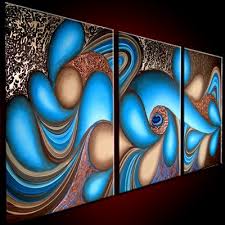


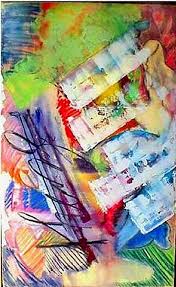

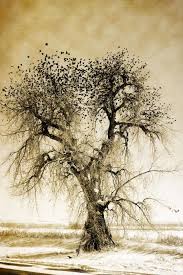
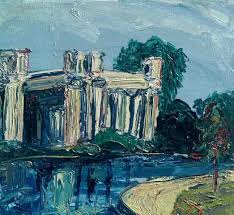
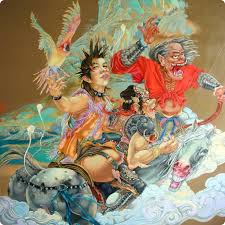
Fine Art Biography
Bing (Chinese: 徐冰 b. 1955) is a Chinese-born artist, resident in the United States since 1990. He currently resides in Beijing, where he serves as the vice-president of the Central Academy of Fine Arts. He is most known for his printmaking skills and installations pieces, as well as his creative artistic use of language, words, and text and how they have affected our understanding of the world.
Contents [hide]
1 Biography
2 Art
2.1 Early Works
2.2 Installation Pieces
2.2.1 A Book from the Sky
2.2.2 Ghosts Pounding the Wall
2.2.3 Background Story
2.3 Later Mediums
3 Influences and themes
4 Awards and honors
5 Partial list of works
6 References
7 External links
[edit]Biography
Born in Chongqing in 1955, Xu grew up in Beijing. In 1975, near the end of the Cultural Revolution, he was relocated to the countryside for two years. Returning to Beijing in 1977, he enrolled at the Central Academy of Fine Arts(CAFA) where he joined the printmaking department, receiving his Masters in Fine Art in 1987. After the Tiananmen Square Protests of 1989 his recent work came under scrutiny from the government and received harsh criticism for what was perceived as a critique of the Chinese government. Due to the political pressure and artistic restrictions of the post-Tiananmen period in China, Xu Bing, like many of his contemporaries, moved to the United States in 1990, where he resided until his appointment as vice-president of the Beijing CAFA in 2008.
In 1990-91, Xu had his first exhibition in the United States at the University of Wisconsin–Madison's Elvehjem Museum of Art (now Chazen Museum of Art) including his installations Book from the Sky and Ghosts Pounding the Wall. In Book from the Sky, the artist invented 4,000 characters and hand-carved them into wood blocks, then used them as movable type to print volumes and scrolls, which are displayed laid out on the floor and hung from the ceiling. The vast planes of text seem to convey ancient wisdom, but are in fact unintelligible. The Glassy Surface of a Lake, a site-specific installation for the Elvehjem, was on view in 2004-05. In this work, a net of cast aluminum letters forming a passage from Henry David Thoreau's Walden stretches across the museum's atrium and pours down into an illegible pile of letters on the floor below.
Xu Bing at the Asian Art Museum of San Francisco on January 28, 2011.
Working in a wide range of media, Xu creates installations that question the idea of communicating meaning through language, demonstrating how both meanings and written words can be easily manipulated. He received a MacArthur Foundation "genius" award in July 1999, presented to him for "originality, creativity, self-direction, and capacity to contribute importantly to society, particularly in printmaking and calligraphy."
In 2003 he exhibited at the then new Chinese Arts centre in Manchester, and in 2004 he won the inaugural "Artes Mundi" prize in Wales for Where does the dust collect itself?, an installation using dust he collected in New York on the day after the destruction of the World Trade Center.[1] He won also a half year of free work and study at the American Academy in Berlin 2004.[2]
Xu Bing was appointed the new vice president of the China Central Academy of Fine Arts in Beijing, March 2008.[3][4]
[edit]Art
[edit]Early Works
While at the Central Academy of Fine Arts Xu Bing mastered the Socialist Realism style of art so predominant during the Maoist era. After graduating with his degree in printmaking, the artist veered away and created simple but dramatic woodcuts, such as Shattered Jade (1977) and Bustling Village on the Water (1980-81, 繁忙的水乡).[5] In 1987, Xu Bing returned to his training in printmaking to create large and elaborate installation pieces like Book from the Sky (1987) and Ghosts Pounding the Wall (1990).
[edit]Installation Pieces
[edit]A Book from the Sky
Xu Bing’s Tianshu (“Book From the Sky”) is a large installation featuring precisely laid out rows of books and hanging scrolls with written “Chinese” texts. Even so, this work challenges our very approach to language because of the unique nature of the text written on the paper. First presented in Beijing in 1988, the learned élite felt slighted by the artists’ bold move to design and print over 4,000 characters that looked Chinese but were completely meaningless according to standard Mandarin.[6] Xu Bing infuses his work with meaning by stirring confusion and discomfort in his audience, mostly due to the fact that the Chinese characters used in these texts are not “real” characters.
This piece was well received in China until 1989, whereupon the social and political drama of the Tiananmen Square protests led the government to look askance at Xu Bing’s Tianshu.[7] Leaving China in 1991 for the political and artistic freedom of the United States, Xu Bing continued to explore and express his thoughts on deconstructing language to challenge our most “natural” cultural assumptions. His thought-provoking work enticed Western audiences, and he soon became one of the leading artists in the modern Chinese art scene.
[edit]Ghosts Pounding the Wall
Using his background in print-making, in May and June 1990 Xu Bing and a team of art students and help from local residents began a monumental project: creating a rubbing from a section of the Great Wall at Jinshanling. In order to create the rubbings, Xu Bing used entirely traditional Chinese methods and materials for stone rubbing, including rice paper and ink. Measuring 32m x 15m, the resulting installation piece consists of 29 rubbings of different sections of the Great Wall.
As is the case of many of his works, Xu Bing directly related his colossal piece "Ghosts Pounding the Wall" to the political situation in China. While surveying his work while installed at Elvehjem Museum of Art, Xu Bing said that his Great Wall represents "a kind of thinking that makes no sense and is very conservative, a really closed-in thinking that symbolizes the isolationism of Chinese politics."[8] The prints of the Great Wall rise up on either side of the exhibit, making the viewer seem small and insignificant in comparison to the massive, looming representations of solid stone walls.
[edit]Background Story
In his series Background Story[9], Xu Bing uses unusual materials in order to create a deceptively typical Chinese Scroll Painting. From the front, the piece very much resembles a traditional Shan Shui (Landscape) scroll painting, with images of mountains, trees, and rivers. However, when seen from behind, the viewer is surprised to find that the beautiful "painting" is in fact created by using the shapes and shadows of random natural plant debris. Once again, Xu Bing challenges his audience's basic assumptions and shows them that everything is not always as it first seems.
[edit]Later Mediums
Xu Bing’s art medium has clearly evolved over the years, morphing from one style to the next: print-making and wood-block carving, installation art, live installation art, metalwork and sculpture, landscaping, and even virtual and digital mediums.
Taking installation art a step further, Xu Bing focused on live installation art by using animals in his exhibits, such as in the case of the Silkworm Series and a Case Study of Transference (using silkworms and pigs, respectively) in 1994, or by showcasing sheep in The Net (1997). Later he explored the combination of modern and traditional mediums, as in the case of Background Story (2004-present) where his work imitates a traditional Chinese brush and ink scroll from the front, but is in fact designed by means of the projected shadows of plants and sticks. Even more recently, Xu Bing has delved into sculpture and metalworking, as seen in Monkeys Grasping the Moon (2001) and the Phoenix Project (2010).[10]
[edit]Influences and themes
Xu Bing's art mostly reflects cultural issues which raged during his early life in tumultuous China. Most notably, the cultural and linguistic reforms enacted by the Communist Party in China under Mao Zedong’s leadership weigh heavily on modern Chinese artists who lived through this period. Similarly, the Cultural Revolution (1966-1976) also rankles the modern Chinese artistic consciousness even though different artists have focused on different angles. Xu Bing in particular plays with the notion of the paradox between the power and fickleness of language, of what it means to be human, and of how our perceptions color our worldview.
Xu Bing plays incessantly with the role, purpose, and reality of language. Early in his life his father would make him write a page of characters a day, encouraging him to not only copy their form to perfection, but also to capture their spirit, their essence.[11] During Mao’s cultural reformations and the reorganization of the standard Chinese language, Xu Bing experienced the constant reformation of words. This constant linguistic change influenced his art: Xu Bing emphasizes the immortality of the essence of language while vividly illustrating the impermanence and capriciousness of words themselves. In this way language becomes malleable and it can be fashioned to either liberate or control. Just as it is nigh impossible to detangle life from politics during the Cultural Revolution era (and its ramifications in decades to follow), Xu Bing also intertwines political messages into his art.
It was not until 2008 that Xu Bing set aside his post-Maoist reactionary art and invested in other topics. For example, he took on environmental projects such as Forest Project,[12] which encouraged the “uninterrupted flow of funds from developed countries to Kenya, earmarked for the planting of new trees.” [13] Even so, his focus is always on the effect that environmental issues have on people, such as the villages in Kenya, not necessarily the effects on the landscape or on the political situation.
At the turn of the millennium, a new defining social pattern emerged after the terrorist attacks in the United States on 9/11, 2001. Tension grew between the West and the Middle East, finally exploding into what was labeled as “the War on Terror.” [14] This situation gave rise to social themes of anxiety and hopelessness seep, which eventually have seeped into the realm of the arts. Even so, some artists like Xu Bing chose to explore the serenity found in the midst of chaos, as illustrated in his work Where does the Dust Itself Collect? (2004, 2011). For this piece, the artist gathered dust from the aftermath of the collapse of the Twin Towers in New York after September 11, 2001, and uses it to recreate the gray film that covered Manhattan in the weeks following the attacks. Stenciled in the dust, a Buddhist poem reads, “As there is nothing from the first, where does the dust itself collect?” Using this tragedy as an expression of the human narrative, Xu Bing contemplates the relationship between the material and the spiritual, and he explores “the complicated circumstances created by different world perspectives.” [15]
[edit]Awards and honors
Honorary Doctor of Humane Letters, Columbia University, New York (2010)
Southern Graphics Council Lifetime Achievement Award (2006)
International Association of Art Critics Award for “Best Installation or Single Work of Art in a Museum, New England” (2006)
The Youth Friends Award, New York (2005)
Artes Mundi Prize (2004)
American Academy in Berlin Coca-Cola Fellowship (2004)
Fukuoka Asian Culture Prize (2003)
MacArthur Award (1999)
Pollack Krasner Foundation Prize (1998)
[edit]Partial list of works
Lanman Shanhua (Brilliant Mountain Flowers) Magazine (1975–1976)
A Book from the Sky (1987–1991)
Ghosts Pounding the Wall (1990–1991)
A.B.C.... (1991–1994)
Post Testament (1992–1993)
Brailliterate (1993)
Introduction to Square-Word Calligraphy (1994–1996)
Oxford Dictionary: Bird Definition (1994–1996)
Silkworm Book (1995)
Lost Letters (1997)
Landscript Postcards (1999–2000)
Red Book (Tobacco Project) (2000)
Book from the Ground (2003-ongoing)
Monkeys Grasping for the Moon (2008-ongoing)
Fine Art
Fine Art
Fine Art
Fine Art
Fine Art
Fine Art
Fine Art
Fine Art
Fine Art
The Fine Art Of Canyon Carving - RideApart
Fine Art Paintings - New iPad Canvas App Spawns Brings Artists Into Digital Age
No comments:
Post a Comment